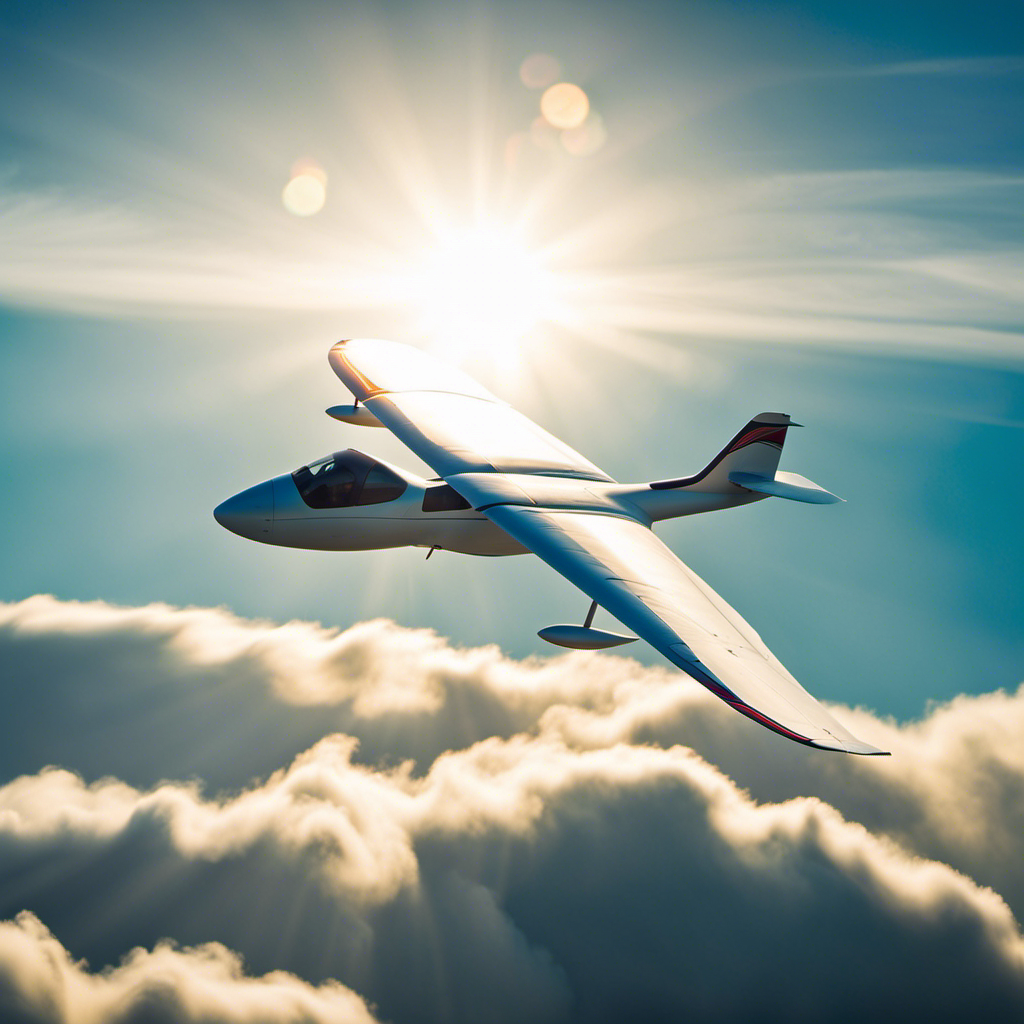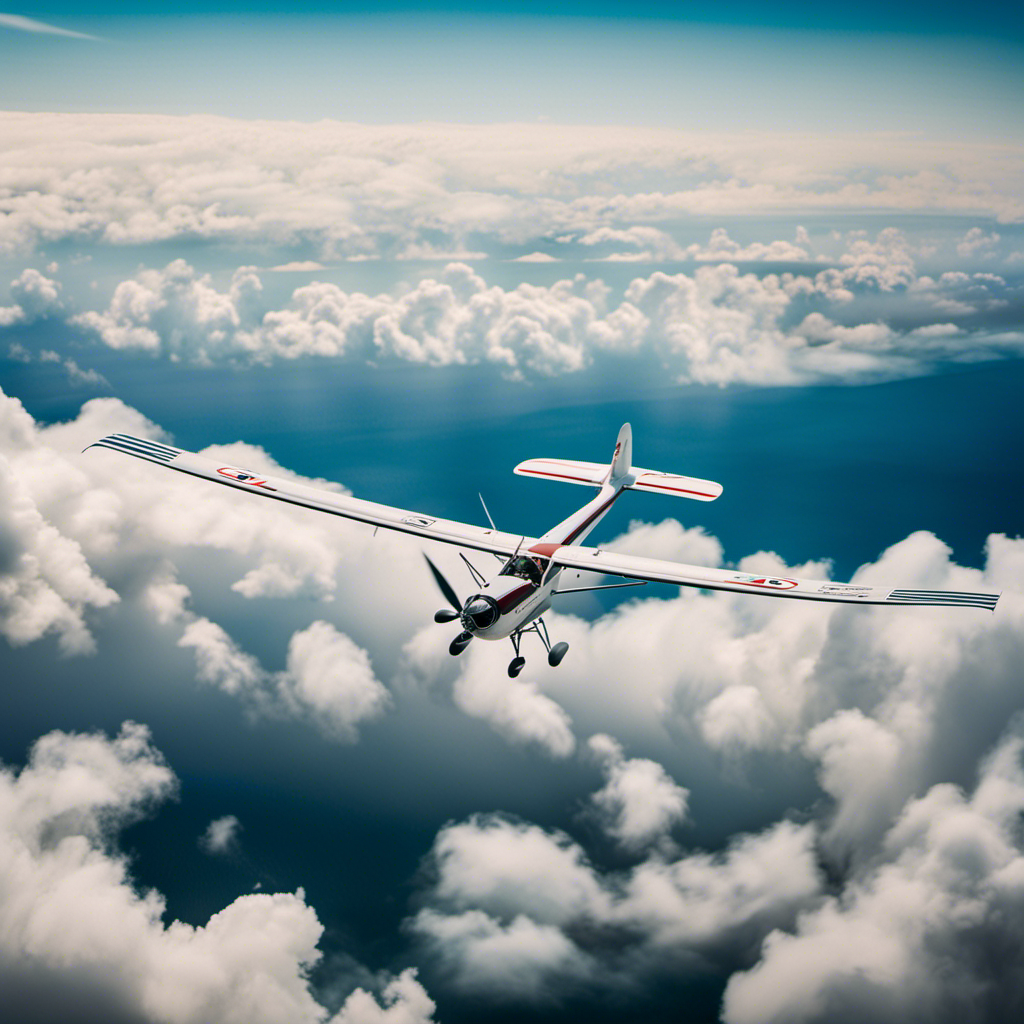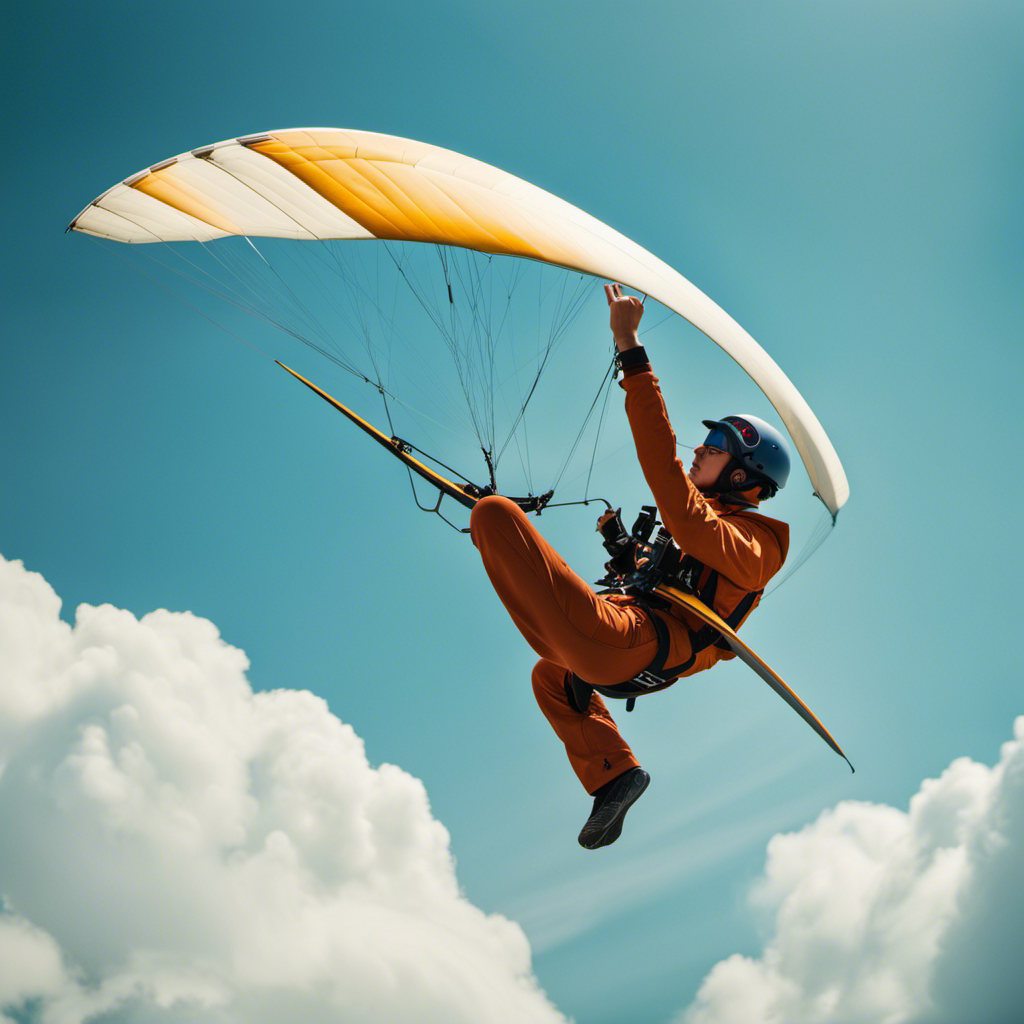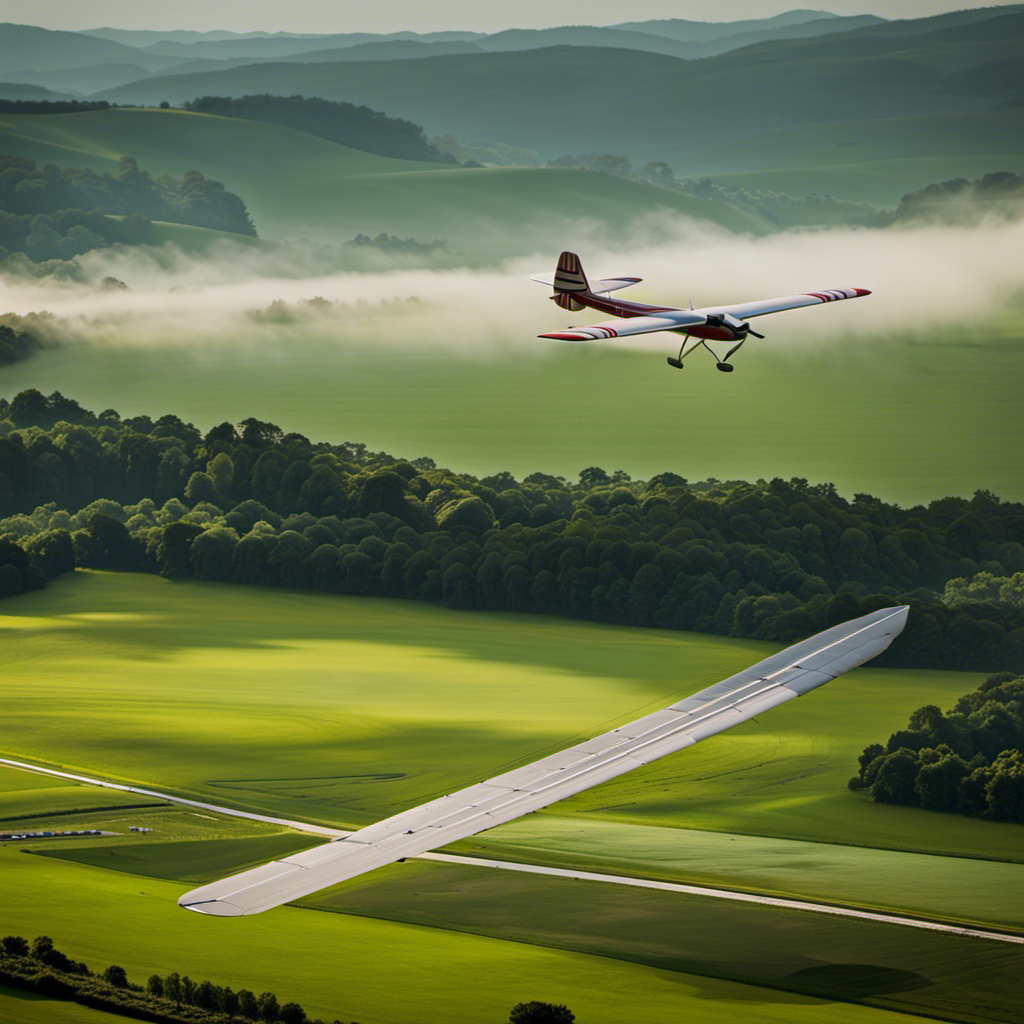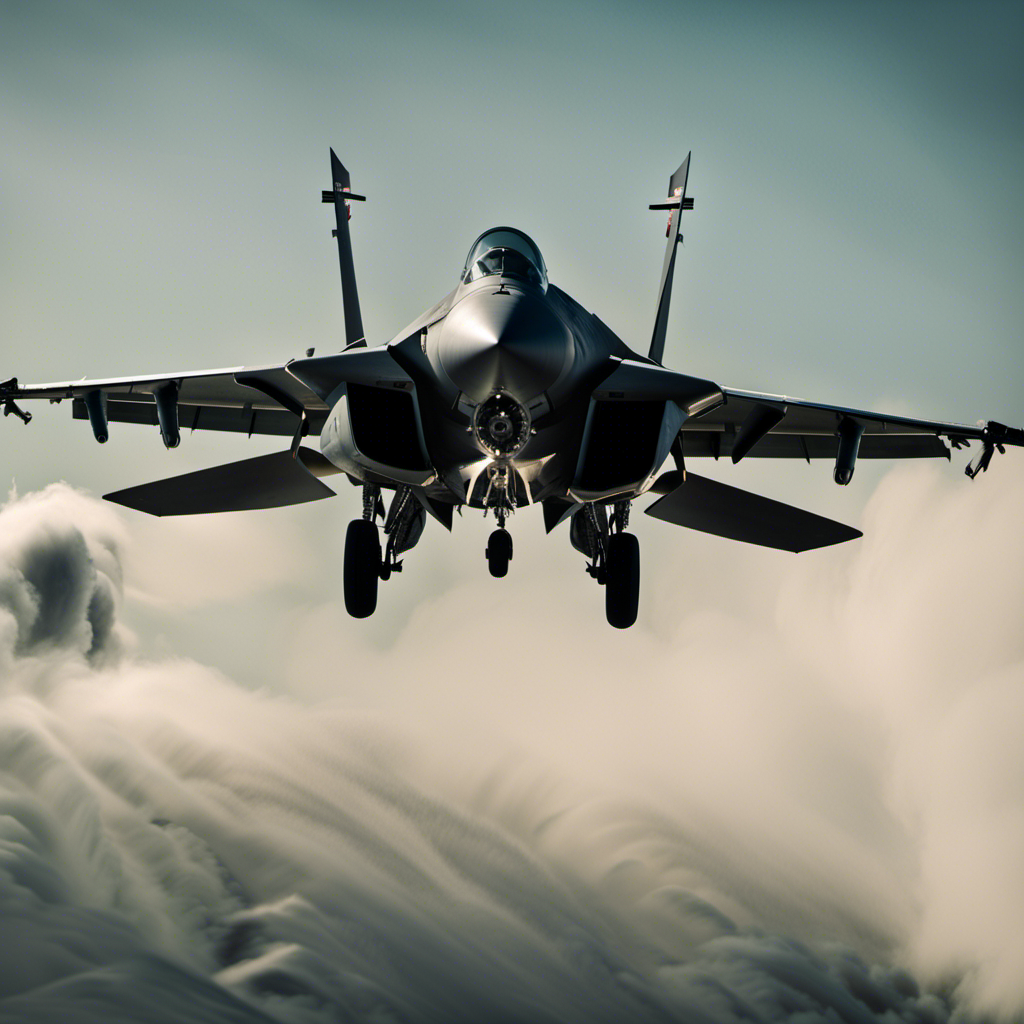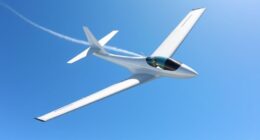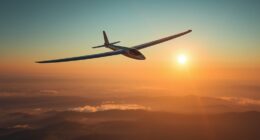As an individual who flies gliders, I have always been mesmerized by the grace and freedom of gliding through the skies. Can gliders still soar without wind?
In this article, we will explore the intricate mechanics of glider flight and delve into the world of air currents, from thermals to ridge lift.
We will also examine the innovative technologies and techniques that allow gliders to conquer the skies even in the absence of wind.
Join me on this journey to uncover the possibilities and challenges of no-wind gliding.
Key Takeaways
- Gliders rely on lift generated by air flow over the wings.
- Gliders can maintain stability and maneuverability without wind.
- Gliders utilize air currents such as thermal updrafts, ridge lift, and wave lift to gain lift and stay aloft.
- Gliders can utilize wind gradients and dynamic soaring techniques to gain energy and increase speed.
Understanding the Basics of Glider Flight
You may be wondering how gliders can fly without wind. To understand this, we need to explore glider flight mechanics and understand glider control techniques.
Gliders rely on the principle of lift to stay airborne. Lift is generated by the flow of air over the wings, and this can be achieved even without wind. The shape of the wings, called the airfoil, plays a crucial role in creating lift.
By adjusting the control surfaces, such as the ailerons and elevators, the pilot can control the glider’s pitch, roll, and yaw. These control techniques allow the glider to maintain stability and maneuverability in the absence of wind.
Now, let’s delve into how gliders utilize air currents for lift.
How Gliders Utilize Air Currents for Lift
Utilizing air currents, gliders are able to gain lift and stay aloft. Gliders rely on the interaction between their wings and the atmospheric conditions to generate the necessary lift. Atmospheric conditions play a crucial role in glider flight.
The glider pilot carefully analyzes the weather patterns, such as thermal updrafts, ridge lift, and wave lift, to determine the best flying conditions. Thermal updrafts are columns of warm air that rise from the ground due to heating. Ridge lift occurs when the wind encounters a mountain or hill and is forced upward, creating an upward force that gliders can use to gain altitude. Wave lift is generated by the interaction between the wind and the mountain range, forming standing waves that gliders can ride.
Understanding these atmospheric phenomena is essential for glider pilots to maximize their lift and prolong their flight.
Now, let’s explore the concept of dynamic soaring.
Exploring the Concept of Dynamic Soaring
To understand dynamic soaring, imagine a glider harnessing the power of wind gradients to gain energy and increase its speed. This technique involves skillfully maneuvering the glider in the changing air currents, utilizing various flight strategies to maximize energy efficiency. Here are four key aspects of dynamic soaring techniques:
-
Wind Gradient Utilization: By exploiting the variations in wind speed and direction at different altitudes, the glider can extract energy from the air mass and convert it into speed.
-
Wave Riding: Gliders can ride on the updrafts created by waves in the atmosphere, which occur when air masses encounter obstacles like mountains or frontal systems. This allows them to gain altitude and maintain or increase their speed.
-
Pendulum Flying: By skillfully alternating between climbing and diving maneuvers, gliders can effectively extract energy from the air mass, using gravity to their advantage.
-
Energy Conservation: Dynamic soaring techniques aim to minimize energy losses by optimizing the flight path, adjusting the glider’s speed and angle of attack to maximize energy efficiency.
By mastering these dynamic soaring techniques, glider pilots can achieve impressive speeds and cover long distances without relying solely on wind currents.
Transitioning to the subsequent section, we will explore the role of thermals in glider flight.
The Role of Thermals in Glider Flight
Transitioning to the role of thermals in glider flight, pilots can harness the rising columns of warm air to gain altitude and maintain speed. Thermals are sources of rising air created by the uneven heating of the Earth’s surface. As the sun heats the ground, the air above it becomes warmer and less dense, causing it to rise.
Glider pilots can locate and enter these thermals to climb higher and extend their flight. By circling within a thermal, pilots can optimize the glider’s performance, using the upward movement of the air to gain altitude. This technique allows gliders to stay aloft for extended periods and cover greater distances.
Now, let’s explore another method of harnessing the power of the atmosphere: ridge lift.
Ridge Lift: Harnessing the Power of Terrain
Ridge lift occurs when wind encounters a slope and is forced to rise, providing glider pilots with an upward force to gain altitude. This phenomenon is particularly useful in areas with hazardous terrain or in windless environments. When the wind encounters a slope, it is deflected upwards, creating a region of rising air on the leeward side of the slope.
Glider pilots can take advantage of this upward force by flying close to the slope, effectively ‘riding’ the rising air. The key to successfully utilizing ridge lift is to find the right slope angle and wind direction. By carefully maneuvering the glider along the ridge, pilots can sustain their altitude or even gain height.
Transitioning into the next section, wave lift takes ridge lift to another level by harnessing invisible atmospheric waves for even greater altitude gains.
Wave Lift: Riding the Invisible Waves in the Sky
Riding the invisible waves in the sky, glider pilots can gain significant altitude by harnessing wave lift. This phenomenon occurs when wind encounters a mountain range or large obstruction, causing the air to be forced upward. As the air rises, it forms invisible wave patterns, similar to the ripples on the surface of water. These waves can extend for miles and provide gliders with a continuous source of lift, enabling them to soar to great heights and cover long distances. To illustrate the efficiency of wave lift, consider the following table:
| Altitude (ft) | Rate of Climb (ft/min) | Glider Efficiency (%) |
|---|---|---|
| 5000 | 300 | 6.0 |
| 10000 | 500 | 5.0 |
| 15000 | 700 | 4.7 |
| 20000 | 900 | 4.5 |
As wind speed increases, glider efficiency improves, allowing pilots to climb higher and faster. This seamless transition between sections allows us to explore the influence of wind speed on glider performance in the next section.
The Influence of Wind Speed on Glider Performance
After exploring the concept of wave lift and how it enables gliders to soar through the sky, I will now delve into the influence of wind speed on glider performance.
Wind speed plays a crucial role in determining the glider’s ability to maintain altitude and achieve forward motion. The force exerted by the wind affects the glider’s airspeed and lift generation, which subsequently impacts its overall performance.
Higher wind speeds can increase the glider’s airspeed, allowing it to generate more lift and maintain flight. Conversely, lower wind speeds can decrease the glider’s airspeed, resulting in reduced lift and potential loss of altitude.
It is important for glider pilots to be aware of the prevailing wind conditions and adjust their flight strategies accordingly to ensure a safe and efficient flight.
Understanding the influence of air pressure and the impact of atmospheric conditions on glider performance is essential in optimizing flight maneuvers and achieving the desired gliding experience.
As we move forward into the subsequent section on glider design and aerodynamics, we will explore how these factors are taken into account to create efficient and high-performing glider models.
Glider Design and Aerodynamics
Glider design and aerodynamics are crucial factors that determine the efficiency and performance of these aircraft. The stability of a glider is essential for safe and controlled flight. To achieve stability, gliders are designed with a high aspect ratio, which is the ratio of the wingspan to the wing area. This allows for better lift-to-drag ratio, resulting in improved aerodynamic efficiency.
Additionally, gliders often incorporate features such as winglets or spoilers to further enhance stability and control. The shape of the wings, fuselage, and tail also play a significant role in glider aerodynamics. Streamlined shapes reduce drag and improve overall performance.
The distribution of weight and balance is another critical aspect of glider design. It affects the handling characteristics and maneuverability of the glider. By maintaining proper weight and balance, pilots can ensure smooth and stable flight transitions.
As we move into the next section, it is important to consider the impact of weight and balance on glider flight.
The Importance of Weight and Balance in Glider Flight
In order to understand the importance of weight and balance in glider flight, it is crucial to consider the effects of weight distribution on stability and control. Weight and balance have a direct impact on the performance and maneuverability of gliders. Maintaining proper weight and balance is essential for safe glider operations.
Weight distribution affects the center of gravity (CG), which plays a significant role in glider stability. If the CG is too far forward, the glider may become nose-heavy, resulting in reduced maneuverability and potential difficulties in controlling the aircraft. On the other hand, if the CG is too far aft, the glider may become tail-heavy, leading to instability and an increased risk of stalling.
Weight and balance calculations are crucial in glider flight. These calculations involve determining the weight of the glider and its components and ensuring that the CG falls within the specified limits. Failure to maintain proper weight and balance can lead to compromised safety and decreased performance.
In conclusion, weight and balance are fundamental factors in glider flight. They directly influence stability, control, maneuverability, and safety. By understanding and maintaining proper weight and balance, pilots can optimize glider performance and ensure a safe flying experience.
Transitioning into the subsequent section about pilot skills and techniques for flying in low-wind conditions, it is essential to consider how these skills and techniques can be applied while also considering the factors of weight and balance in glider flight.
Pilot Skills and Techniques for Flying in Low-Wind Conditions
When flying in low-wind conditions, you’ll need to rely on your skills and techniques to maintain control and stability. Pilot training plays a crucial role in preparing for such situations. Learning how to make precise and smooth control inputs is essential to ensure the glider remains stable and responsive.
Additionally, understanding the aerodynamics of the glider and how it interacts with the air is crucial for flying in no-wind situations. Equipment requirements also come into play. Gliders designed for low-wind conditions often feature longer wings and higher aspect ratios, allowing for better performance in these conditions.
Transitioning from flying in normal wind conditions to low-wind conditions can present challenges, but with the right training and equipment, pilots can overcome these limitations and safely navigate the skies.
Challenges and Limitations of Gliders in No-Wind Situations
Transitioning from the previous subtopic on pilot skills and techniques for flying in low-wind conditions, it is important to acknowledge the challenges and limitations that gliders face in no-wind situations. When there is no wind, gliders heavily rely on other factors to generate lift and maintain flight. However, this presents several challenges and limitations that pilots must overcome:
-
Limited altitude gain: Without wind, gliders struggle to gain altitude, making it difficult to stay airborne for extended periods.
-
Reduced control: In no-wind situations, gliders experience decreased control over their flight path, making it challenging to navigate and maneuver effectively.
-
Increased dependency on thermals: Gliders heavily rely on thermals, which are pockets of warm air, to generate lift. However, finding and utilizing thermals can be unpredictable and inconsistent.
-
Limited cross-country flying: No-wind conditions can limit the distance gliders can travel, hindering their ability to explore new areas.
Understanding these challenges and limitations is crucial for glider pilots. However, innovative technologies and techniques for no-wind gliding offer potential solutions to overcome these obstacles and enhance the performance and capabilities of gliders.
Innovative Technologies and Techniques for No-Wind Gliding
Despite the challenges and limitations faced in no-wind situations, innovative technologies and techniques offer potential solutions to enhance the performance and capabilities of gliders.
One area of focus is the development of no-wind glider technology, which aims to improve the efficiency and maneuverability of gliders in calm air conditions. These advancements include the use of lightweight materials, streamlined designs, and advanced wing profiles that generate lift even in the absence of wind.
Additionally, alternative propulsion methods, such as electric motors and solar panels, are being explored to provide gliders with the ability to self-launch and sustain flight without relying on thermal updrafts.
These advancements in no-wind glider technology have the potential to revolutionize the sport of gliding by enabling longer flights and expanding the range of possible flying conditions. However, such advancements must be accompanied by thorough safety considerations to ensure the well-being of pilots flying without wind.
Safety Considerations for Gliders Flying Without Wind
To ensure your safety while flying in calm air conditions, it is important to carefully consider the potential risks and take necessary precautions. Here are some key safety precautions to keep in mind when gliding without wind:
- Proper pre-flight planning and preparation, including a thorough inspection of the glider and its equipment.
- Always wearing a properly fitted and secure harness to prevent injury in the event of turbulence or sudden movements.
- Familiarizing yourself with emergency procedures, such as how to handle a stall or loss of lift, and practicing them regularly.
- Maintaining situational awareness at all times, monitoring weather conditions and potential hazards.
- Having a communication system in place to stay connected with ground support or other gliders in the area.
By following these safety precautions and being prepared for emergencies, you can enhance your safety while gliding without wind.
Looking ahead, let’s explore the future of gliding: advancements and possibilities in this exciting field.
The Future of Gliding: Advancements and Possibilities
After exploring the safety considerations for gliders flying without wind, let’s now shift our focus to the future of gliding.
Advancements in glider technology have opened up new possibilities and potential applications for this exhilarating sport.
One promising advancement is the development of electric-powered gliders. These gliders are equipped with electric motors, allowing them to take off without the need for a tow plane or a hill. Electric-powered gliders offer the advantage of silent and sustainable flight, as they rely on rechargeable batteries instead of fossil fuels.
Furthermore, advancements in materials and aerodynamics have led to the design of more efficient and maneuverable gliders. These gliders have improved glide ratios, enabling pilots to cover longer distances and stay aloft for extended periods.
In the future, we can expect to see gliders being used for various purposes beyond recreational flying. They could be utilized for aerial photography and surveying, environmental monitoring, and even as a means of transportation for short distances.
With these advancements and future applications on the horizon, the world of gliding is brimming with excitement and potential. So, let’s now delve into the conclusion: the thrill and beauty of gliding, with or without wind.
Conclusion: The Thrill and Beauty of Gliding, with or without Wind
In conclusion, the world of gliding is filled with exhilaration and natural beauty, whether the wind is present or not. Glider competitions showcase the skill and precision of pilots as they navigate the skies, relying on their knowledge of aerodynamics and thermals to stay aloft. These events foster a sense of camaraderie among gliding enthusiasts, who come together to celebrate their shared passion for this exhilarating sport. Glider maintenance plays a crucial role in ensuring the safety and performance of these aircraft. Regular inspections and repairs are necessary to keep the gliders in top condition, allowing pilots to soar through the air with confidence. The beauty of gliding lies not only in the thrill of flying but also in the meticulous care and attention given to these remarkable machines.
| Glider Competitions | Glider Maintenance |
|---|---|
| Test of skill | Safety inspections |
| Precision maneuvers | Repairs |
| Camaraderie | Performance checks |
Frequently Asked Questions
What are the safety considerations for gliders flying without wind?
Safety measures for gliders flying without wind include strict pilot training to handle the unique challenges. Without wind, gliders must rely on thermals or ridge lift for sustained flight. Pilots must also be well-versed in emergency procedures and weather forecasting.
What are the challenges and limitations of gliders in no-wind situations?
The challenges and limitations of gliders in no-wind situations include a decreased ability to maintain altitude, limited maneuverability, and the need for alternative methods of propulsion such as a tow or a motor.
What innovative technologies and techniques are used for no-wind gliding?
Electric propulsion is a key technology for no-wind gliding. Solar cells convert sunlight into electricity, powering the glider’s electric motor. This allows gliders to fly even when there is no wind, making them more versatile and efficient.
How does wind speed affect glider performance?
Wind speed has a significant impact on glider performance. Higher wind speeds increase lift, allowing the glider to stay aloft at lower speeds. This results in a better glide ratio, enabling the glider to cover more distance with less altitude loss.
What are the advancements and possibilities for the future of gliding?
Artificial intelligence has the potential to revolutionize gliding by optimizing performance and navigation. Additionally, advancements in renewable energy could provide sustainable power sources for gliders, allowing for longer flights and reducing environmental impact. Exciting possibilities lie ahead!
Conclusion
As I reflect on the thrilling world of gliding, I am reminded of the timeless tale of the phoenix rising from its ashes.
Gliders, like the phoenix, have the remarkable ability to defy gravity and soar through the sky with grace and elegance. Whether it be through harnessing air currents, dynamic soaring, or utilizing thermals and ridge lift, gliders have mastered the art of flight without the need for wind.
With advancements in technology and techniques, the future of gliding holds endless possibilities. This ensures that the beauty and thrill of gliding will continue to captivate our hearts, even in the absence of wind.
With a heart that soars as high as the skies, Aria, affectionately known as “Skylark,” is the driving force behind Soaring Skyways. Her journey into the gliding world began as a young dreamer gazing up at the soaring birds, yearning to experience the weightlessness and freedom they embodied. With years of experience both in the cockpit and behind the scenes, Aria’s commitment to the gliding community is unwavering.
